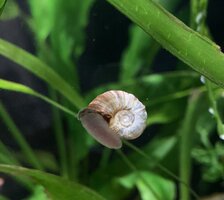jellybean
Member
Hi all, first post here. I have a planted tank with a once large ramshorn snail colony that is now dwindling. Shells are turning white. Kh is 3 and Gh is 8. No co2 injection. I’ve read through posts here and am trying to figure out my best plan of action. Glasgarten baby shrimp food? Cuttlebone? Anything else I can try? Thanks for your help. 





